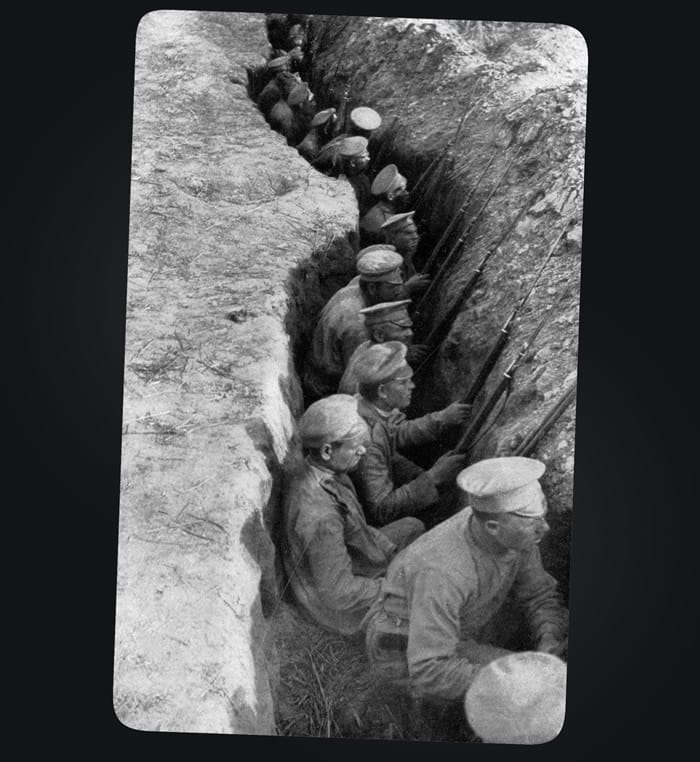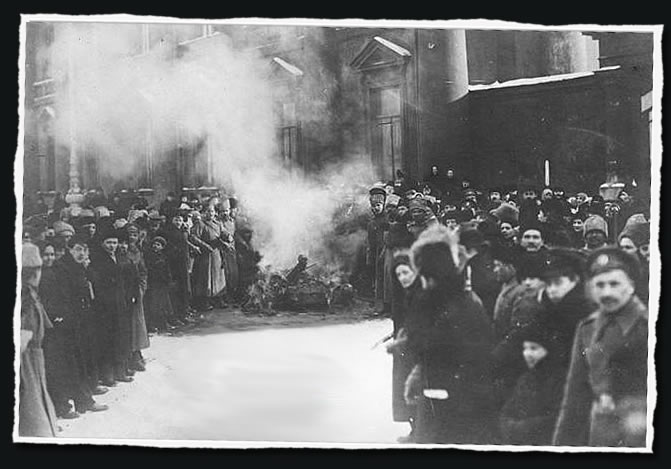In The Footsteps Of Revolution
Revisiting scenes from Russia’s tumultuous 1917 revolution.
Photos And Text - Amos Chapple
Digital Production - Wojtek Grojec
The events of 1917 changed the course of Russian, and indeed world, history. But as these remarkable then-and-now pictures show, pockets of Russia's two largest cities have endured almost unchanged through a century of revolution and the fall, rise, and fall of empire.


St. Petersburg
The Winter Palace
Tsar Nicholas II makes a public address on July 20, 1914. A few days later, the tsar would mobilize troops to defend Russia's "little Slavic brothers" in Serbia who were under a barrage of Austrian artillery. This conflict would soon expand into World War I.
The cheering crowds below Nicholas on that summer day had little inkling of it, but their tsar was standing on the edge of an abyss.
1914 Photo: Beinecke Rare Book and Manuscript Library, Yale University
Russia was ill-prepared for war against a coalition led by the highly industrialized Germany. By 1917, the battlefields of WWI had taken around 1 million Russian lives, most of them peasants and workers in soldiers' uniforms who would otherwise have been feeding and supplying Russia's cities. Shortages and hunger became the norm in wartime Russia.
In a country where the glittering lives of the nobility had long bred resentment among the lower classes, the war was giving rise to increasingly dark mutterings in the streets and factories. Much of the hostility was directed toward the German-born Tsarina Aleksandra Feodorovna, who many believed was nothing more than a bejeweled German spy.

(Public Domain)
Russia was ill-prepared for war against a coalition led by the highly industrialized Germany. By 1917, the battlefields of WWI had taken around 1 million Russian lives, most of them peasants and workers in soldiers' uniforms who would otherwise have been feeding and supplying Russia's cities. Shortages and hunger became the norm in wartime Russia.
In a country where the glittering lives of the nobility had long bred resentment among the lower classes, the war was giving rise to increasingly dark mutterings in the streets and factories. Much of the hostility was directed toward the German-born Tsarina Aleksandra Feodorovna, who many believed was nothing more than a bejeweled German spy.

With Tsar Nicholas away at the front commanding Russia's war effort, the capital, St. Petersburg (then called Petrograd), was left in Aleksandra's hands. Her "spiritual adviser" was the Siberian mystic Grigory Rasputin, a Russian peasant whose pursuit of prostitutes and raucous drinking sessions had tainted the tsar and tsarina by association.

(Public Domain)
In February 1917, thousands of goods trains that should have supplied the people of St. Petersburg with flour, coal, and wood were disabled by icy blizzards. It was the final element in a perfect storm of anger toward the tsar and his family.
On February 22 (old calendar), hungry protesters took to the streets demanding bread. As the numbers swelled, St. Petersburg's wide streets echoed to chants of "Down with the autocracy, down with the war."
Nicholas, on the way to the front in his imperial train, misjudged the depth of feeling back in his capital and demanded that his troops clear the streets by any means necessary. Volleys of police bullets tore through the crowds of protesters, but there was a limit to how much blood the tsar's forces were prepared to shed. One soldier, ordered to shoot into a crowd, summed up the mood of many: "Our fathers, mothers, sisters, brothers, and brides are begging for bread. Are we going to kill them?"
St. Petersburg
Field Of Mars
A funeral for casualties of the revolution.
1917 Photo: Shutterstock


St. Petersburg
Field Of Mars
A funeral for casualties of the revolution.
1917 Photo: Shutterstock


Moscow
Red Square
The revolution soon spread throughout Russia. This political speech in Moscow was photographed in the early days of the February Revolution.
1917 Photo: Alamy
Soon a full-blown mutiny had swept through the troops of St. Petersburg, and the tsar, who believed he had been "born for misfortune," had few options left. As tsarist symbols were torn down and burned on the streets, the tsar's train was shunted to safety in a lonely railway siding. Inside his carriage, after his advisers "begged" him to stand down, Nicholas gave up his throne and was soon taken into captivity, along with his family. More than 300 years of Romanov rule over Russia was at an end.

Soon a full-blown mutiny had swept through the troops of St. Petersburg, and the tsar, who believed he had been "born for misfortune," had few options left. As tsarist symbols were torn down and burned on the streets, the tsar's train was shunted to safety in a lonely railway siding. Inside his carriage, after his advisers "begged" him to stand down, Nicholas gave up his throne and was soon taken into captivity, along with his family. More than 300 years of Romanov rule over Russia was at an end.

St. Petersburg
Palace Square
A truckload of soldiers in central St. Petersburg. Such vehicles sped through the streets like "huge hedgehogs run amok" following the February Revolution.
1917 Photo: Shutterstock


St. Petersburg
Palace Square
A truckload of soldiers in central St. Petersburg. Such vehicles sped through the streets like "huge hedgehogs run amok" following the February Revolution.
1917 Photo: Shutterstock


St. Petersburg
Alexander Palace
Three of the former tsar's daughters along with his son, the former heir to the Russian throne, in captivity near St. Petersburg. Just over a year after this photo was taken, the entire family was shot and bayonetted to death by Bolshevik revolutionaries.
1917 Photo: : Tass
In the euphoric atmosphere following the abdication, a temporary or "provisional" authority stepped in to run the country. Alongside this provisional government, ordinary workers and soldiers formed councils (soviets) to make sure their voices would be represented in the coming decisions facing Russia. The weightiest of those decisions was whether Russia would continue fighting in the war.
St. Petersburg
Field Of Mars
A demonstration in St. Petersburg in May. That spring, Russia had become what was touted as "the freest country in the world" and the streets buzzed with ad hoc political meetings.
1917 Photo: Public Domain


St. Petersburg
Field Of Mars
A demonstration in St. Petersburg in May. That spring, Russia had become what was touted as "the freest country in the world" and the streets buzzed with ad hoc political meetings.
1917 Photo: Public Domain

It was at this crucial juncture that Germany sent the exiled revolutionary Vladimir Lenin, who was opposed to the war, toward Russia. Germany gambled that even if he failed to take power and seek peace with Germany, his presence would, like a "plague bacillus," afflict Russia with further chaos.
When the provisional government called not only for continuation of the war but for preparations for a major attack against Germany, there was more uproar on the streets. Thousands marched in St. Petersburg demanding that the people's councils take control from the provisional government, who many felt were working against the revolution. Despite being almost powerless against the armed, angry crowds, the provisional government was not unseated and the councils failed to take control. One protester screamed at a councilor, "Take power, you son of a bitch, when it's handed to you."
It was at this crucial juncture that Germany sent the exiled revolutionary Vladimir Lenin, who was opposed to the war, toward Russia. Germany gambled that even if he failed to take power and seek peace with Germany, his presence would, like a "plague bacillus," afflict Russia with further chaos.

When the provisional government called not only for continuation of the war but for preparations for a major attack against Germany, there was more uproar on the streets. Thousands marched in St. Petersburg demanding that the people's councils take control from the provisional government, who many felt were working against the revolution. Despite being almost powerless against the armed, angry crowds, the provisional government was not unseated and the councils failed to take control. One protester screamed at a councilor, "Take power, you son of a bitch, when it's handed to you."


St. Petersburg
Palace Square
Protesters march in favor of continuing the war effort. The lead banner reads, "In the name of freedom, [continue] the war against Germanism until full victory." But pro-war sentiment dwindled after the offensive launched against Germany in July ended disastrously for Russia.
1917 Photo: Sputnik
Moscow
Red Square
Members of a "women's death battalion" swear an oath before being sent to the front. Battalions of women were intended to shame the men into continuing the fight against Germany.
1917 Photo: Sputnik


Moscow
Red Square
Members of a "women's death battalion" swear an oath before being sent to the front. Battalions of women were intended to shame the men into continuing the fight against Germany.
1917 Photo: Sputnik


Moscow
Red Square
Soldiers parade before heading into battle. With a revolution in the rear, discipline at the front was collapsing and desertions and mutiny became commonplace. One senior commissar, attempting to address a band of deserting troops, was beaten to death. By July, hopes of a democratic and humane Russia were evaporating in the summer air.
1917 Photo: Tass
St. Petersburg
Nevsky Prospekt
A demonstration of Bolshevik supporters in central St. Petersburg.
1917 Photo: Shutterstock


St. Petersburg
Nevsky Prospekt
A demonstration of Bolshevik supporters in central Saint Petersburg.
1917 Photo: Shutterstock
With no one apparently willing to seize power, Lenin and his Bolsheviks, a group of revolutionary extremists who wanted to sweep away the old regime and enact a system where the working class held all political power, were beginning to be seen as a viable alternative to the discredited provisional government. With their promise of "bread, peace, and land," the movement was gaining some support among the sailors and soldiers whose bayonets were the real keys to power during that summer of chaos.


St. Petersburg
The Winter Palace
Soldiers tasked with guarding the provisional government inside the Winter Palace days before it was stormed by soldiers and sailors fighting on behalf of Lenin’s Bolsheviks.
1917 Photo: Tass
Lenin, who had again fled Russia a wanted man after the violence of that summer, returned to St. Petersburg disguised as a railway worker and set about planning to seize power through a carefully organized military operation.
Hundreds of sailors and soldiers had been won over by charismatic Bolshevik activists and agreed to take part in the operation. What would become known as the October "revolution" in fact looked more like a coup.
St. Petersburg
St. Isaac’s Square
These Cossack troops, loyal to the provisional government, likely soon melted away as the Bolshevized sailors and soldiers fanned out through the city, seizing key buildings and infrastructure.
1917 Photo: Getty Images


St. Petersburg
St. Isaac’s Square
These Cossack troops, loyal to the provisional government, likely soon melted away as the Bolshevized sailors and soldiers fanned out through the city, seizing key buildings and infrastructure.
1917 Photo: Getty Images


St. Petersburg
Smolny Institute
On October 26, any members of the provisional government who hadn't fled were arrested and the streets of St. Petersburg belonged to the Bolsheviks. These three men are guarding a side road leading to the Smolny Institute, which had become Lenin's headquarters after the October Revolution.
1917 Photo: Public Domain
Moscow
Gorky Park
Bolshevik troops in Moscow. By early November, Moscow was also under the control of Bolshevik fighters.
1917 Photo: Sputnik


Moscow
Gorky Park
Bolshevik troops in Moscow. By early November, Moscow was also under the control of Bolshevik fighters.
1917 Photo: Sputnik
Lenin held power, but his promise of peace with Germany came at a terrible cost, including the loss of one-third of the Russian empire's population and three-quarters of its industry. The humiliating treaty rallied massive opposition to Lenin and his Bolsheviks.


Moscow
Theater Square
Lenin speaking in central Moscow. By 1918, the revolution had morphed into a civil war between Lenin's "Red" Bolsheviks and a collection of forces known as the "Whites." The violence in Russia was just beginning.
1920 Photo: Public Domain
In August 1918, a Bolshevik newspaper heralded Russia's new era with the promise: "We will kill our enemies in scores of hundreds. Let them be thousands, let them drown themselves in their own blood. For the blood of Lenin…let there be floods of blood of the bourgeoisie – more blood, as much as possible."